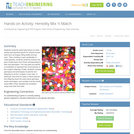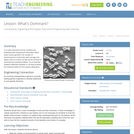
5 Results


Students randomly select jelly beans (or other candy) that represent genes for several human traits such as tongue-rolling ability and eye color. Then, working in pairs (preferably of mixed gender), students randomly choose new pairs of jelly beans from those corresponding to their own genotypes. The new pairs are placed on toothpicks to represent the chromosomes of the couple's offspring. Finally, students compare genotypes and phenotypes of parents and offspring for all the "couples" in the class. In particular, they look to see if there are cases where parents and offspring share the exact same genotype and/or phenotype, and consider how the results would differ if they repeated the simulation using more than four traits.
- Subject:
- Applied Science
- Engineering
- Genetics
- Life Science
- Material Type:
- Activity/Lab
- Lesson Plan
- Provider:
- TeachEngineering
- Provider Set:
- TeachEngineering
- Author:
- Mary R. Hebrank
- Date Added:
- 09/26/2008

Explore natural selection by controlling the environment and causing mutations in bunnies.
- Subject:
- Genetics
- Life Science
- Material Type:
- Simulation
- Provider:
- University of Colorado Boulder
- Provider Set:
- PhET Interactive Simulations
- Author:
- Jonathan Olson
- Noah Podolefsky
- Wendy Adams
- Date Added:
- 04/01/2009

This resource is a video abstract of a research paper created by Research Square on behalf of its authors. It provides a synopsis that's easy to understand, and can be used to introduce the topics it covers to students, researchers, and the general public. The video's transcript is also provided in full, with a portion provided below for preview:
"Housemates, science shows, share more than just space. The types of microbes that colonize the gut tend to be similar among members of the same family or household. But where does the sharing begin: through contact, environment, or diet? And do more social factors like status play a role? To find out, researchers recently examined the microbiomes of seven neighboring groups of wild Verreaux’s sifakas in Madagascar. Sifakas in the same group tended to have more similar microbiomes, but differences between groups weren’t explained by differences in diet, home range, or habitat. Maternal lineage was an important driver of similarity within groups and may also explain why adult group members, which are generally less related, shared the least similar gut microbiota. In addition, dominant males had different microbiomes than their group-mates, possibly because of rank-related differences in physiology and scent-marking behaviors..."
The rest of the transcript, along with a link to the research itself, is available on the resource itself.
- Subject:
- Biology
- Life Science
- Material Type:
- Diagram/Illustration
- Reading
- Provider:
- Research Square
- Provider Set:
- Video Bytes
- Date Added:
- 05/18/2022

In a class discussion format, the teacher presents background information about basic human genetics. The number of chromosomes in both body cells and egg and sperm cells is covered, as well as the concept of dominant and recessive alleles. Students determine whether or not they possess the dominant allele for the tongue-rolling gene as an example.
- Subject:
- Applied Science
- Engineering
- Genetics
- Life Science
- Material Type:
- Activity/Lab
- Lesson Plan
- Provider:
- TeachEngineering
- Provider Set:
- TeachEngineering
- Author:
- Mary R. Hebrank
- Date Added:
- 09/18/2014